Optical fiber pigtail refers to a broken end of an optical fiber core with a bit connector at one end and a broken end of an optical fiber core at the other end. It is often present in the optical fiber terminal box to connect the optical cable and the optical fiber transceiver (couplers and jumpers are also used between them).
After the completion of optical cable laying, a complete optical fiber transmission link must be formed through optical fiber connection. There are many connection points in an optical fiber link, including optical fiber direct connection point, connector termination and connector interconnection, so optical fiber connection also has two forms of connection and termination.
Fiber termination is the process of connecting an optical fiber connector with an optical fiber and polishing it. In order to reduce the connection loss, it is required to connect the connector and polish the end of the optical fiber connector. Fiber termination is mainly used to make fiber jumper and fiber pigtail.
The fiber tail is relatively thin. The cross section of the fiber tail is an inclined plane with an angle of 8 ° and is not resistant to high temperature. If it is over 100 ℃, it will peel off.
It should be noted that fiber pigtail and jumper are not the same concept. Only one end of optical fiber pigtail is a movable joint, and both ends of jumper are movable joints. There are many kinds of interfaces. Different interfaces need different couplers, and the jumper can be used as pigtail.
Product features:
1. The high-quality material with low insertion loss and reflection has good optical performance. It can be easily installed with the adapter. The enhanced and tensile design provides high mechanical stability. The high-precision ceramic insert with small concentricity error and inner hole diameter provides extra insertion loss and return loss, avoiding the degradation of transmission performance and damage of optical transceiver.
2. Advanced grinding technology and equipment are used to ensure that the technical parameters such as the center grinding offset of optical fiber, the concave of optical fiber and the curvature radius of ceramic end face meet the specified standards.
3. In order to ensure the long-term use of the connector, not only the attenuation and back reflection of the connector are tested, but also the scratches or defects on the joint surface are tested by using the precise interferometer. The curvature half warp, grinding offset, optical fiber sag and protrusion of FC, ST, SC and LC joints are measured to ensure the quality of the connector.
4. 100% optical detection, each jumper is guaranteed to have good grinding quality and excellent performance index.
5. Fiber optic products also have PVC and LSOH different fire rating sheath, providing design flexibility.
6. It has the advantages of small insertion loss, large return loss, excellent interchangeability and repeated insertion and extraction performance, and is easy to use.

Application
Optical fiber communication system
Optical access network
Optical fiber data transmission
Optical fiber CATV
Local area network (LAN)
Test equipment
Optical fiber sensor
Serial server
FTTH/FTTX
Telecommunication network and pre termination installation.
Types of pigtails
According to the existing ODF rack and equipment port standards, fiber hopping can be divided into the following types:
1. According to the interface type: the pigtail interface can be divided into FC, SC and LC, and the two ends are FC-FC, SC-SC, LC-LC, fc-sc, fc-lc, sc-lc, a total of six fiber hopping types.
2. According to the length of interface: the length of pigtail varies. At present, the commonly used ones are 3M, 5m, 10m, 15m and 20m.
3. Purpose: FC interface is used to connect ODF frame with remote fiber core; SC interface is used for ODF frame and equipment, such as OLT and ONU equipment interface and photoelectric converter interface in EPON; LC interface is only used for equipment interface.
In the theory of optical fiber communication, optical fiber can be divided into single-mode and multi-mode. The core diameter difference between multimode PIGTAIL (50 μ m) and single-mode PIGTAIL (8-11 μ m) is very large. The difference is that:
1. Single mode fiber has small core diameter (about 8-10 mm), only one mode transmission is allowed, and the dispersion is small. It works at long wavelength (1310nm and 1550nm), so it is relatively difficult to couple with optical devices. The single-mode pigtail is yellow and the transmission distance is 10km-40km and 40km-120km respectively
2. The core diameter of multimode fiber is large (62.5mm or 50mm), allowing hundreds of modes to transmit, with large dispersion, working at 850nm or 1310nm. Coupling with optical devices is relatively easy. The multi-mode pigtail is orange and the transmission distance is 500m-2km, which is used for short-distance interconnection.
Summary:
Long single mode transmission distance
Large single mode transmission bandwidth
Single mode dispersion does not occur and the quality is reliable
Single mode usually uses laser as light source, which is expensive, while multimode communication usually uses cheap LED
Single mode price is relatively high, multi-mode price is cheap, short-range transmission can be
The pigtail has various connectors. The diameter of common pigtail is usually 0.9mm and installed in ODF device.
Matters needing attention:
1. In order to reduce the attenuation of optical signal in the process of transmission, the loop winding should be avoided as far as possible.
2. The optical module connected with the pigtail must match with the pigtail, the short wave optical module must be connected with multi-mode tail fiber, and the long wave optical module must be connected with single-mode jumper, so as to ensure the accuracy of data transmission.
3. The connector of pigtail should be kept clean, and the connector should be protected and sealed with protective sleeve after use to prevent oil stain, dust and mechanical damage.
4. Before use, it is necessary to wipe the ceramic plug and the end face of the plug with alcohol.
5. When the pigtail is damaged by human or other factors, the damaged jumper should be replaced in time.
contact:support@htfuture.com
Skype:sales5_ 1909,WeChat:16635025029





















